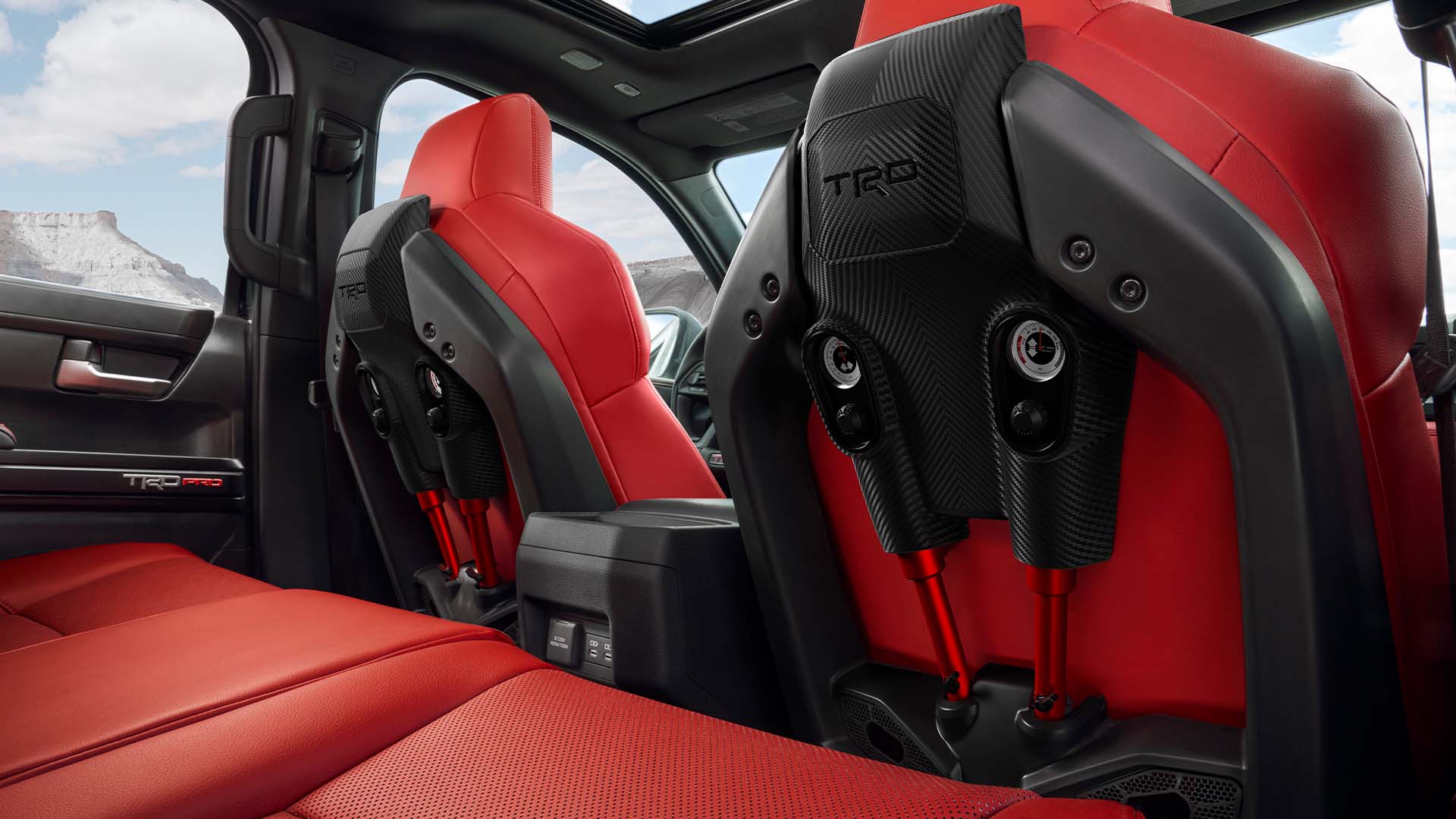

There’s a good chance you’ve seen the 2024 Toyota Tacoma by now. We knew that the fourth-generation Taco was coming this year, and forum leaks earlier in May confirmed a radical redesign. Now, with the rig officially unveiled by Toyota’s truck folks on Friday, we’ve got a good look at the midsize pickup and its greatest features—like seats with their own shock absorbers.
Now, sure, there are a lot of other details to geek out over. The two-door Xtra Cab is one thing to be excited about, and then there’s the six-speed manual, as well as a powerful hybrid powertrain. But the Tacoma TRD Pro’s all-new IsoDynamic Performance Seats are something else.

The idea behind them is actually pretty easy to understand. Essentially, Toyota mounted a pair of air-over-oil shock absorbers to the seatback. The application provides damping for both vertical and lateral movement, helping to float the driver over any sharp bumps that the truck’s Fox internal bypass shocks can’t smooth out on their own.
“We were looking to do something and provide better stabilization of the driver and the occupant in those high-speed or even some of the tactical off-road driving scenarios,” the Tacoma’s chief engineer Sheldon Brown told The Drive. “If you think about, for example, a downhill skier or even if you look to the wild you see a cheetah chasing its prey. The eyes are focused and fixed, the body is moving but the head and the eyes are staying stable, so the goal here is to stabilize the upper torso, particularly the head. In an off-road driving scene, you’re getting bounced and thrown around a little bit. So, that was the genesis of how we thought about this seat. We started with some very basic technology, obviously increasing the bolsters both in the seat as well as in the rear seat back. And that obviously helps snuggle up the occupant, makes sure they’re nice and tight. In the front, we added a swivel joint.
“In the back is our superstructure. It’s a hot-formed steel tube. We basically blow it and quench it so we get the strength out of that. Obviously, that adds a little bit of mass, so behind this we have gone from a metal back frame and a metal seat pan to a reinforced resin and that helps us take some of the mass back out of the seat. The way this fundamentally works is we have the swivel joint there in the front, we have a spring-loaded ball joint and then, of course, we have an articulation structure below. What we have here is air over oil and what we can do is with a simple air Schrader valve, you can pull this off with something like a mountain bike-type pump, you can pump that up and we can set it to a specific pressure. We give you recommended pressures based on the occupant’s mass and then from there, you can customize it however you like and you can change the damping force.”






“How it works is we have lateral dampers and we have vertical dampers,” Brown continued. “So as you’re driving down the road and you’re getting these large inputs coming from the vehicle, basically the seat is able to articulate and to move and then these are, of course, dampening and reducing that force. In total, we can take about 7% of what we’ll say is the impact load that’s coming in to the occupant which significantly reduces fatigue. Because these are not necessarily huge events and for those, we can knock the peak off, but it’s all that vibration and all that input that starts to tire the driver out over the course of an off-road environment. So as you start to use it, we put in these little ring identifiers or locators that help you better customize the seat.
“You can see how much lateral or vertical displacement you had and then you can adjust the damping force either up or down by increasing or reducing the pressure. Let’s just say you’re mostly going to be out on the street most of the week and you’re driving to work and you don’t necessarily want to have the dynamic seat working, you simply turn these 90 degrees and you lock out the vertical and horizontal, it acts just like a regular seat. The seat has got every amenity that the high-level trims do including ventilation, heat, power, fore, aft, up, down—the only thing that we changed here is we do have a manual recline.”

Now, the IsoDynamic Performance Seats are only available on the TRD Pro trim, which means that those purchasing the truck’s smaller Xtra Cab (which I fully support, because two-door trucks rock in an otherwise oversized market) won’t be able to get them from the factory. It also means that you can’t pair them with a manual transmission since only the SR, TRD Sport, and TRD Off-Road are offered with a row-your-own six-speed.
“I can tell you anecdotally that when we give folks a chance to drive with this seat off versus with it on, the same trail, typically we’ll see them run it maybe 10, 15, 20 mph faster just because you’re not moving around, you feel like your body’s in control, you’re focused, you’re able to maintain control of the vehicle,” Brown concluded. “So it definitely inspires confidence, this is all about confident, natural driving and this is an extension of that philosophy.”
These seats are a segment-first, and really, I can’t think of anything else like them except for a semi-truck’s driver seat with air ride underneath. It’ll be interesting to see how drivers and passengers react to using them in real life, as dampened seats provide a way different feel from traditional ones. Either way, I’m willing to bet hardcore off-roaders will thank Toyota after their first long day on the trails.
Got a tip or question for the author? Contact them directly: rob@thedrive.com